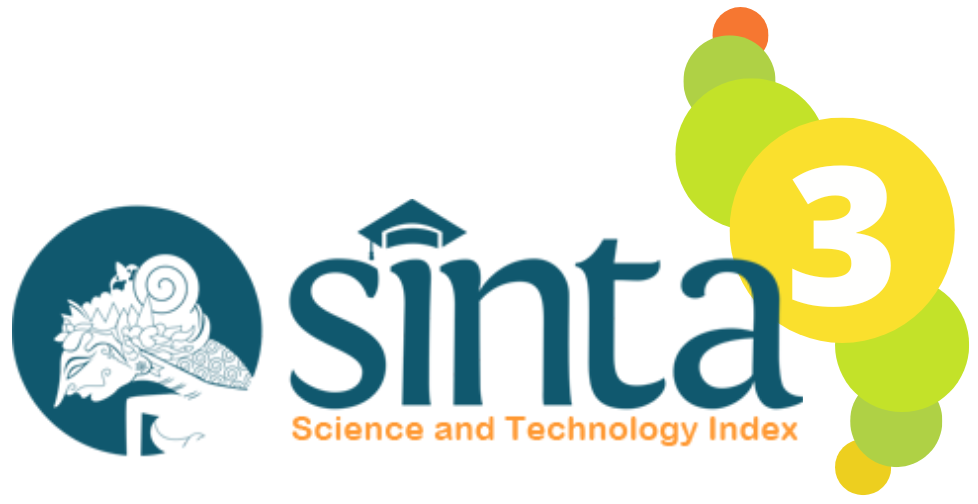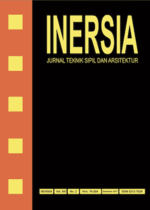The Influence of Cement Type on Seawater-Affected Concrete Impermeability
DOI:
https://doi.org/10.21831/inersia.v20i2.75738Keywords:
(Sea Water, Type of Cements, GGBFS, Impermeabillity, Ratio)Abstract
The impermeability of concrete exposed to seawater is key in maintaining long-term structural integrity. In an exposed environment, concrete must be able to protect itself from seawater penetration which can potentially cause damage, corrosion and material degradation. This study aims to investigate the effect of different types of cement on the impermeability of concrete using Ground Granulated Blast-furnace (GGBFS) as concrete filler based on gradation to obtain dense concrete, especially when exposed to seawater during the maintenance period with age variations of 7, 28, and 56 days. Three types of cement available in the general public were used, namely, type V, Portland Composite Cement (PCC), Portland Pozzolan Cement (PPC). The research method used was experimental testing with 6 variations with the dimensions of a cylinder measuring 15x15x30 cm 3 and a cube measuring 15x15x15 cm3. The results obtained in the form of compressive strength test with the highest elastic modulus is cement type V GGBFS of 48.12 MPa with elastic modulus 38153.21 MPa while the smallest is Portland Pozzolan Cement (PPC) 35.93 MPa and 26339.61 MPa for elastic modulus. In this study, concrete mixes with Ground Granulated Blast Furnace Slag (GGBFS) showed a significant increase in compressive strength over time, despite initially having lower strength than regular cement mixes. The use of GGBFS in concrete offers long-term benefits, with the potential to achieve higher compressive strengths. This study demonstrates the importance of considering treatment time and the use of GGBFS in designing more durable and robust concrete mixes.
References
I. J. Navarro, V. Yepes, and J. V. Martí, "Life cycle cost assessment of preventive strategies applied to prestressed concrete bridges exposed to chlorides," Sustainability (Switzerland), vol. 10, no. 3, Mar. 2018, doi: 10.3390/su10030845.
M. Mohd, O. Zainon, A. W. Rasib, and Z. Majid, "The study on the durability of submerged structure displacement due to concrete failure," in International Archives of the Photogrammetry, Remote Sensing and Spatial Information Sciences - ISPRS Archives, International Society for Photogrammetry and Remote Sensing, Sep. 2016, pp. 345–350. doi: 10.5194/isprs-archives-XLII-4-W1-345-2016.
D. L. Pillay, O. B. Olalusi, P. O. Awoyera, C. Rondon, A. M. Echeverría, and J. T. Kolawole, "A Review of the Engineering Properties of Metakaolin Based Concrete: Towards Combatting Chloride Attack in Coastal/Marine Structures," Advances in Civil Engineering, vol. 2020. Hindawi Limited, 2020. doi: 10.1155/2020/8880974.
P. Duan, Z. Shui, W. Chen, and C. Shen, "Influence of metakaolin on pore structure-related properties and thermodynamic stability of hydrate phases of concrete in seawater environment," Constr Build Mater, vol. 36, pp. 947–953, Nov. 2012, doi: 10.1016/j.conbuildmat.2012.06.073.
G. Zhao, M. Shi, M. Guo, and H. Fan, "Degradation mechanism of concrete subjected to external sulfate attack: Comparison of different curing conditions," Materials, vol. 13, no. 14, Jul. 2020, doi: 10.3390/ma13143179.
S. J. Price and R. B. Figueira, "Corrosion protection systems and fatigue corrosion in offshore wind structures: Current status and future perspectives," Coatings, vol. 7, no. 2. MDPI AG, Feb. 01, 2017. doi: 10.3390/coatings7020025.
H. W. Song and V. Saraswathy, "Studies on the corrosion resistance of reinforced steel in concrete with ground granulated blast-furnace slag-An overview," Journal of Hazardous Materials, vol. 138, no. 2. pp. 226–233, Nov. 16, 2006. doi: 10.1016/j.jhazmat.2006.07.022.
P. Åukowski, A. Salih, and J. J. SokoÅ‚owska, "Frost resistance of concretes containing ground granulated blast-furnace slag," in MATEC Web of Conferences, EDP Sciences, Jun. 2018. doi: 10.1051/matecconf/201816305001.
P. Åukowski and A. Salih, "Durability of mortars containing ground granulated blast-furnace slag in acid and sulphate environment," in Procedia Engineering, Elsevier Ltd, 2015, pp. 47–54. doi: 10.1016/j.proeng.2015.06.118.
M. Ben Haha, B. Lothenbach, G. Le Saout, and F. Winnefeld, "Influence of slag chemistry on the hydration of alkali-activated blast-furnace slag - Part II: Effect of Al2O3," Cem Concr Res, vol. 42, no. 1, pp. 74–83, Jan. 2012, doi: 10.1016/j.cemconres.2011.08.005.
C. H. Huang, C. H. Wu, S. K. Lin, and T. Yen, "Effect of slag particle size on fracture toughness of concrete," Applied Sciences (Switzerland), vol. 9, no. 4, Feb. 2019, doi: 10.3390/app9040805.
P. Nath and P. K. Sarker, "Effect of GGBFS on setting, workability and early strength properties of fly ash geopolymer concrete cured in ambient condition," Constr Build Mater, vol. 66, pp. 163–171, Sep. 2014, doi: 10.1016/j.conbuildmat.2014.05.080.
í‡. Yalí§Ä±nkaya and O. í‡opuroÄŸlu, "Hydration heat, strength and microstructure characteristics of UHPC containing blast furnace slag," Journal of Building Engineering, vol. 34, Feb. 2021, doi: 10.1016/j.jobe.2020.101915.
R. A. T. Cahyani and Y. Rusdianto, "Concrete Performance with Ground Granulated Blast Furnace Slag as Supplementary Cementitious Materials," in IOP Conference Series: Materials Science and Engineering, Institute of Physics Publishing, Mar. 2020. doi: 10.1088/1757-899X/771/1/012062.
N. Bheel et al., "Fresh and hardened properties of concrete incorporating binary blend of metakaolin and ground granulated blast furnace slag as supplementary cementitious material," Advances in Civil Engineering, vol. 2020, 2020, doi: 10.1155/2020/8851030.
H. M. Yang, S. J. Kwon, N. V. Myung, J. K. Singh, H. S. Lee, and S. Mandal, "Evaluation of strength development in concrete with ground granulated blast furnace slag using apparent activation energy," Materials, vol. 13, no. 2, Jan. 2020, doi: 10.3390/ma13020442.
M. G. Subarkah, J. Sjah, and I. J. Maknun, "Effects of Ground Granulated Blast Furnace Slag and Recycled Coarse Aggregates in Compressive Strength of Concrete," in IOP Conference Series: Earth and Environmental Science, Institute of Physics Publishing, Jun. 2020. doi: 10.1088/1755-1315/498/1/012045.
S. Safie Mahdi Oleiwi, "Compressive Strength of Mortar with Partial Replacement of Cement by Fly Ash and GGBFS.," Diyala Journal of Engineering Sciences, vol. 14, no. 4, pp. 146–155, Dec. 2021, doi: 10.24237/djes.2021.14412.
A. Subagdja, A. Sofyan, and A. Rusmanto, "Compressive strength and permeability of concrete by using GGBFS against seawater," in IOP Conference Series: Materials Science and Engineering, Institute of Physics Publishing, May 2020. doi: 10.1088/1757-899X/830/2/022045.
Muhammad Kemal Rafif and Alfinna Mahya Ummati, "Pengaruh pasang surut air laut terhadap kekuatan beton komposit material Ground Granulated Blast Furnace Slag (GGBFS)," PADURAKSA: Jurnal Teknik Sipil Universitas Warmadewa, vol. 12, no. 2, pp. 218–227, Dec. 2023, doi: 10.22225/pd.12.2.6518.218-227.
M. Shariq, J. Prasad, and A. Masood, "Effect of GGBFS on time dependent compressive strength of concrete," Constr Build Mater, vol. 24, no. 8, pp. 1469–1478, Aug. 2010, doi: 10.1016/j.conbuildmat.2010.01.007.
Downloads
Published
How to Cite
Issue
Section
License
Authors who publish with INERSIA journal agree to the following terms:
- Authors retain copyright and grant the INERSIA journal right of first publication with the work simultaneously licensed under Creative Commons Attribution License (CC BY 4.0) that allows others to share the work with an acknowledgment of the work's authorship and initial publication in this journal.
- Authors can enter into separate, additional contractual arrangements for the non-exclusive distribution of the published version of the work (e.g., post it to an institutional repository or edit it in a book), with an acknowledgment of its initial publication in this journal.
- Authors are permitted and encouraged to post their work online (e.g., in institutional repositories or on their website) before and during the submission process, as it can lead to productive exchanges, as well as earlier and greater citation of published work.

INERSIA by https://journal.uny.ac.id/index.php/inersia was distributed under a Creative Commons Attribution 4.0 International License











